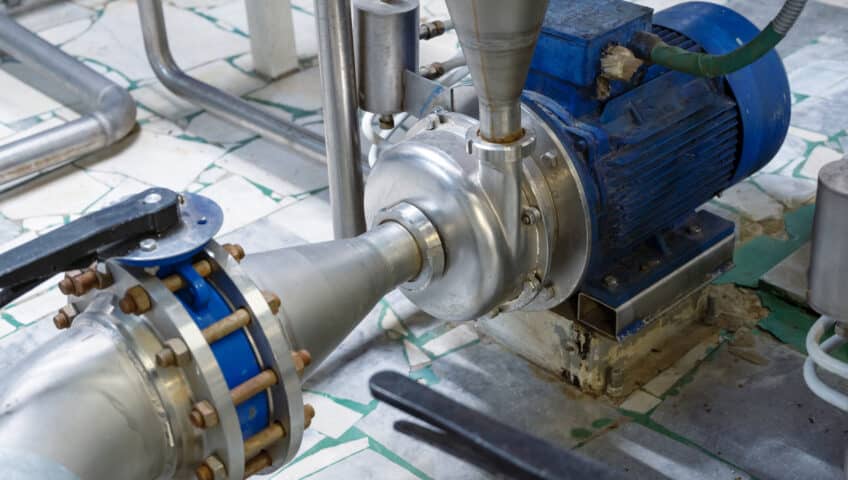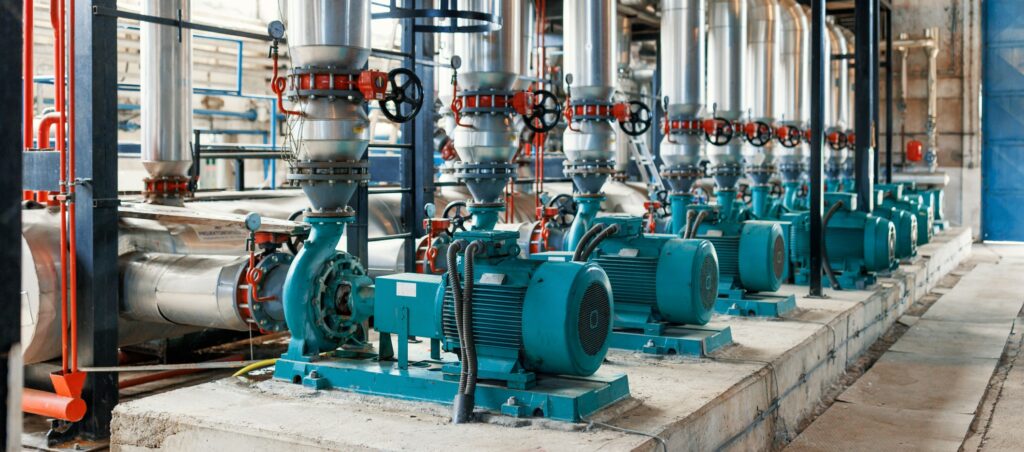
Troubleshooting Common Industrial Pump Problems
When your operation hinges on the reliable function of industrial pumps, understanding the intricacies of industrial pump repair is not just beneficial—it’s a necessity. In the demanding landscape of American industry, where efficiency translates to success, your ability to navigate and implement maintenance tips for industrial pumps can significantly impact your bottom line.
Industrial pump repair is a critical aspect of maintaining the efficiency and longevity of machinery in various sectors. From manufacturing plants to water treatment facilities, the reliability of these pumps is crucial.
In this blog, we’ll provide an in-depth look at some of the most common industrial pump repair issues and how to troubleshoot them, as well as discuss preventative maintenance strategies to keep your pumps in optimal condition. Continue reading below to learn more and discover how C&B Equipment can help you mitigate downtime and sustain operational efficiency.
Understanding the Mechanics of Industrial Pump
To ensure their continued efficiency, a thorough understanding of industrial pump maintenance and repairing industrial pumps is critical. These mechanisms are complex, and grasping how they operate is the first step toward effective maintenance.
Industrial pumps come in many variations, each designed to fulfill specific needs within different industry operations. The most common types include:
Centrifugal Pumps: Utilize a rotating impeller to impart velocity to the fluid, converting that velocity into flow.
Positive Displacement Pumps: Transport fluid by trapping a fixed amount and forcing (displacing) that trapped volume into the discharge pipe.
Submersible Pumps: Positioned within the fluid they are pumping and completely sealed to prevent fluid from entering the motor.
Each of these pump types is composed of critical components that must function harmoniously to maintain operational efficiency. Failure to properly understand the specifications and maintenance needs of these parts can lead to costly downtime and repairs.
Common Industrial Pump Issues
As an integral component of the industrial landscape, pumps are prone to a variety of issues that can impede their operation and efficiency. Being aware of these problems is crucial to minimizing downtime and ensuring continued productivity.
Let’s delve into the three most common challenges faced by these vital machines and explore strategies to diagnose and prevent them.
Leakage and Seal Failure
Leakage is often a sign of seal failure, an issue that not only leads to product loss but can also pose safety and environmental hazards. Recognizing the symptoms, such as visible leaks or a drop in pressure, can prevent more significant damage.
The causes of seal failures are manifold, including improper installation, misalignment, and deterioration due to the pumped fluid’s properties. As a part of proactive maintenance, it’s essential to regularly inspect seals and gaskets and replace them as necessary to ensure a tight, secure pump operation.
Bearing and Lubrication Problems
Bearings reduce friction within the moving parts of a pump and, if not adequately lubricated, can lead to overheating and failure. Telltale signs of bearing troubles include unusual noises or vibrations and a rise in temperature.
The root of these issues often lies in insufficient or contaminated lubrication. To circumvent such dilemmas, it’s essential to adhere to a lubrication schedule, utilize the correct type of oil or grease, and check for contaminant ingress that can compromise bearing life.
Impeller Wear and Damage
An impeller’s condition is pivotal to a pump’s performance. Damage or excessive wear to the impeller can cause decreased flow rates and increased power consumption. Indicators of impeller issues include reduced pressure and capacity or increased power usage.
Debris in the fluid, corrosion, and cavitation are common culprits for impeller degradation. Incorporating regular inspection and cleaning protocols, along with monitoring for cavitation, is vital in preventing impeller wear and maintaining efficient pump operation.

Step-by-Step Guide to Industrial Pump Repair
Industrial pump repair can be a daunting task. However, with a logical and systematic approach, you can effectively troubleshoot issues and restore performance.
This step-by-step pump troubleshooting guide is designed to aid you in repairing industrial pumps while ensuring safety and efficiency. By following these critical stages, you’ll gain the confidence to tackle even the more challenging malfunctions you might encounter.
Initial Assessment
Begin by conducting a thorough examination of the pump. Check for any visible signs of damage or wear, listen for irregular noises, and observe any unusual vibration levels. Make sure to note any leakage or seal degradation, which are common indicators of pump failure. Documenting these initial observations can provide valuable insight into the underlying issues.
Review Operational Data
Examine the pump’s operational history, including maintenance records and performance data, to identify any patterns or previous issues that could be contributing to the current problem. This step may highlight recurring complications that require a more permanent solution.
Isolate the Pump
For safety reasons and to prevent any further damage, isolate the pump from the system. Turn off the power supply, close valves, and relieve any pressure. Ensure the pump is secure and safe to work on before proceeding with the repair process.
Disassembly
Using the appropriate tools, carefully dismantle the pump to access the internal components. This includes removing the casing, dismounting the impellers, and extracting bearings and seals. Take care to keep all parts organized and note their arrangement for later reassembly.
Inspection and Diagnosis
With the pump disassembled, thoroughly inspect its components for signs of damage or wear, such as cracks, corrosion, or abrasion. This inspection will help identify the specific parts that require attention or replacement.
Component Repair or Replacement
After pinpointing the malfunctioning parts, move forward by either repairing or replacing them. It’s essential to use quality replacement parts that match the original specifications to ensure reliability and performance post-repair.
Reassembly
Once repairs or replacements are complete, reassemble the pump, ensuring that all components are correctly aligned and positioned. Careful reassembly is crucial in preventing future issues and prolonging the life of the pump.
Testing
After reassembly, perform a test run to verify that the pump is operating correctly. Monitor for leaks and abnormal noises and ensure that pressure and flow rates are within normal operating parameters.
Post-Repair Inspection
Final checks are crucial in the repair process. Inspect the pump once more while it is running to confirm that all repairs have been successful and that no new issues have arisen.
Documentation
Document the repair process, noting the issues found, parts replaced, and any adjustments made. Keeping accurate records is essential for future maintenance and troubleshooting efforts.
Repair Techniques for Common Pump Issues
When you encounter setbacks with your industrial pumps, having a set of proven repair techniques can be the difference between a quick fix and extended downtime. Whether it’s leakage, seal failure, lubrication problems, or impeller damage, understanding how to navigate these issues is an integral aspect of industrial pump maintenance.
Here is a detailed look at the repair methods tailored for some of the most common challenges in industrial pump repair:
Leakage and Seal Failures
- Inspect the seal area for any foreign particles or signs of wear that might breach the seal’s integrity.
- Check for proper seal installation according to manufacturer’s specifications to ensure alignment and fit.
- Replace defective seals with new ones that match the exact specifications for material and dimensions to prevent future leaks.
Bearing and Lubrication Issues
- Listen for any abnormal sounds emanating from the bearings and feel for excessive heat, which can indicate lubrication issues.
- Clean and re-lubricate bearings with the appropriate grease or oil, following the pump’s maintenance guidelines.
- If the damage is beyond simple lubrication, consider bearing replacement, ensuring bearings are correctly installed and aligned.
Impeller Wear and Damage
- Examine the impeller for any signs of erosion, corrosion, or cavitation damage, paying careful attention to blade integrity.
- Clean the impeller and the surrounding pump chamber to remove any obstructions or build-up causing performance issues.
- If repair is not viable due to the severity of wear or damage, replace the impeller entirely with one that conforms to the original specifications.
Preventive Maintenance for Industrial Pumps
Preventive maintenance is the cornerstone of reliable operational workflows. Instituting a maintenance protocol tailored to your unique system can profoundly impact its longevity and functionality.
Below are essential maintenance tips for industrial pumps designed to sustain their efficiency and prevent the distress of unexpected failures.
Develop a Maintenance Schedule
Adhering to a routine inspection schedule ensures that any issues can be identified before they escalate into costly repairs. Pumps should be checked daily, weekly, and monthly, with more comprehensive reviews occurring quarterly and annually.
Regular Cleaning
Keep the pumps and surrounding areas clean. Debris can cause blockages and, over time, lead to pump failure. Inspect strainers and filters regularly and clean them as needed.
Lubrication
Bearings and other moving parts require proper lubrication to operate smoothly. Utilize the recommended lubricants and follow the manufacturer’s instructions for application frequency and quantity.
Seal and Gasket Inspections
Seals and gaskets are critical for preventing leaks and maintaining pressure. They should be regularly examined and replaced as needed to ensure the integrity of the pump’s internal environment.
Planning for Part Replacements
Retain an inventory of essential spare parts. This preparedness minimizes downtime in situations where a component needs urgent replacement.
Streamline Your Operations with C&B Equipment’s Industrial Solutions
These hands-on repair techniques are foundational for addressing and rectifying the typical challenges faced in industrial pump repair and maintenance. Regular application of these practices will help maintain your equipment’s optimal performance and longevity, ultimately safeguarding your industrial operations against unforeseen disruptions.
At C&B Equipment, we understand the critical importance of maintaining seamless operations in your industrial environment. Our expertise in providing top-tier pumps, compressors, blowers, and related equipment is unmatched in the industry. With our team of experienced engineers and technicians, you can be sure you receive customized solutions tailored to your specific needs, enhancing both productivity and efficiency.
Don’t let equipment failures slow down your business. Contact C&B Equipment today and experience the difference that our engineered solutions can make in your industrial operations.

